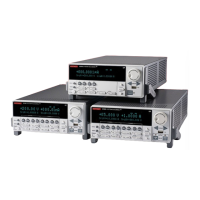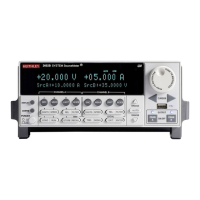12-22 Instrument Control Library Series 2600 System SourceMeters Reference Manual
2600S-901-01 Rev. A / May 2006 Return to Section 12 topics
Remarks
• tmode can be expressed as a number (1, 2, 3 or 5) or as one of the pre-defined
constants (see “Usage”).
• When reading the trigger mode, it is returned as a number.
Details See “Controlling digital I/O lines” in Section 10.
Example
Sets the trigger mode for I/O line 4 to TRIG_RISING:
digio.trigger[4].mode = 2
digio.trigger[N].pulsewidth
N is a digital I/O trigger line: 1 to 14
Attribute The length of time that the trigger line will be asserted for output triggers.
Usage
width = digio.trigger[N].pulsewidth -- Reads pulsewidth.
digio.trigger[N].pulsewidth = width -- Writes pulsewidth.
width Pulsewidth length (seconds).
Remarks
• The trigger line is guaranteed to be asserted for at least the specified time, and it
might be asserted slightly longer.
• Setting pulsewidth to 0 (seconds) asserts the trigger indefinitely.
• The default pulsewidth time is 10µs.
Details See “Controlling digital I/O lines” in Section 10.
Also see digio.trigger[N].release
Example
Sets pulsewidth for trigger line 4 to 20µs:
digio.trigger[4].pulsewidth = 20e-6
digio.trigger[N].release
N is a digital I/O trigger line: 1 to 14
Function Releases an indefinite length or latched trigger.
Usage
digio.trigger[N].release()
Remarks Releases a trigger that was asserted with an indefinite pulsewidth, as well as a trigger
that was asserted in response to receiving a synchronous mode trigger. Only the
specified trigger line (N) is affected.
Details See “Controlling digital I/O lines” in Section 10.
Also see digio.trigger[N].pulsewidth
Example
Releases trigger line 4:
digio.trigger[4].release()

